"Mały", "Bocian", "Dzieciol", "Sojka" and, "Sokol" went to their families.
Following the breakup of "Wilk" December of 1943 into 3 sections or groups, 2/Lt. Jan Stachura "Adam" started a new section then called "Adam's section", later renamed "Mszyca",
around Rabka and Mszana Dolna with its new base camp at Lubon and at a before-the-war YMCA camp on the Lubogoszcz Mountain.
The territory where the "Mszyca" unit operated was one of the most picturesque landscapes of southern Poland.
The valleys of several rivers: Dunajec, Raba, Porabka, Konina and Mszanka dissect a bundle of beautiful mountain ranges: western part of Beskid Wyspowy and northern part of Gorce Mountains.
Rich history of the region goes back in time all the way to the 14th century when first written notes mention Mszana Goma and Olszowka.
Although John and I were NOT involved with "Mszyca", we stayed with Lt. Krystyn Wieckowski "Zawisza" in the reformulated "Wilk", I nonetheless retained a number of close friendships
with the men in this group.
The MEMOIRS of Józef Węglarz (ps "Mały"), who was a key member of the "Mszyca" unit, provide a very insightful view of the operation of the Polish
resistance units that were operating in southern Poland at the time and extracts are reproduced below.
"MSZYCA" PERSONNEL
"Mszyca" Section Personnel (January 1944 - January 1945)
AKA "Adam's" Section, as of September 1944 formally: 4th Company, 2nd Battalion, 1st Regiment (1 PSP-AK)
Image Courtesy: Estate of Józef Węglarz "Mały"

|
|
The number of members in the unit fluctuated and depended on the then current situation. The number oscillated between 30 and about 80 by the end of its existence (highest numbers in the summer and fall of 1944).
Most soldiers were locals but also one officer originally was from Yugoslavia, one was a Pole who deserted from the German army and also a Russian - taken prisoner, a former Wlasow's Army soldier.
The Inspectorat in Nowy Saez directed the unit's deployments and all the personnel changes including day-to-day routines and campsites.
Three-quarters of the unit's entire personnel were former Polish army officers and soldiers. The remaining one-quarter were new recruits and needed a complete basic training.
The following were personnel were responsible for this training of the new recruits:
- Gunnery Master Antoni Malec "Kmicic",
- Sgt. Stefan Feryński "Sęp",
- Platoon Leader Władysław Kroczka "Gawor",
- plut. Józef Makuła "Tygrys",
- Cpl. Józef Kołodziejczyk "Dziecioł",
- and Cadet Józef Węglarz "Mały"
Associated with the "Mszyca" Section was a small group stationed at the Lubon Wielki hence its name the "Lubon" Section. The personnel constantly fluctuated here.
Originally led by Cadet Wladyslaw Rogowiec "Witold", later by 2nd Lt. Roman Medwicz "Morski" who created the so-called "Assault Group" ("Grupy Szturmowej").
The "Lubon" Group participated in a number of operations with
the "Mszyca" Section.
"LUBON" Section Personnel (January 1944 - January 1945)
A small group associated with the "Mszyca" Section stationed at the Lubon Wielki.
Image Courtesy: Estate of Józef Węglarz "Mały"
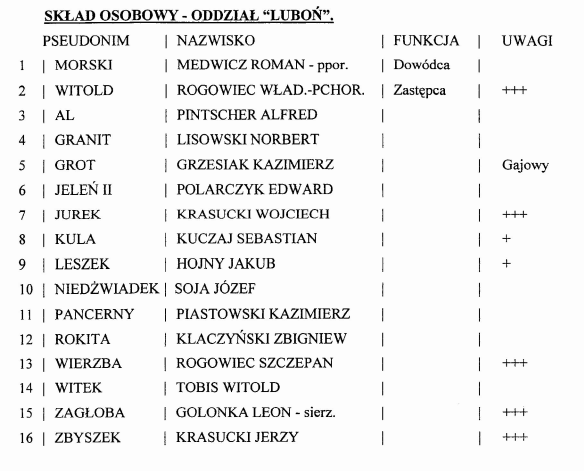
|
|
"MSZYCA" HOUSEKEEPING DEPARTMENT
1944 Photo: Platoon Leader Tadeusz Wacławik "Długi"
Photo Courtesy:
Estate of Józef Węglarz "Mały"
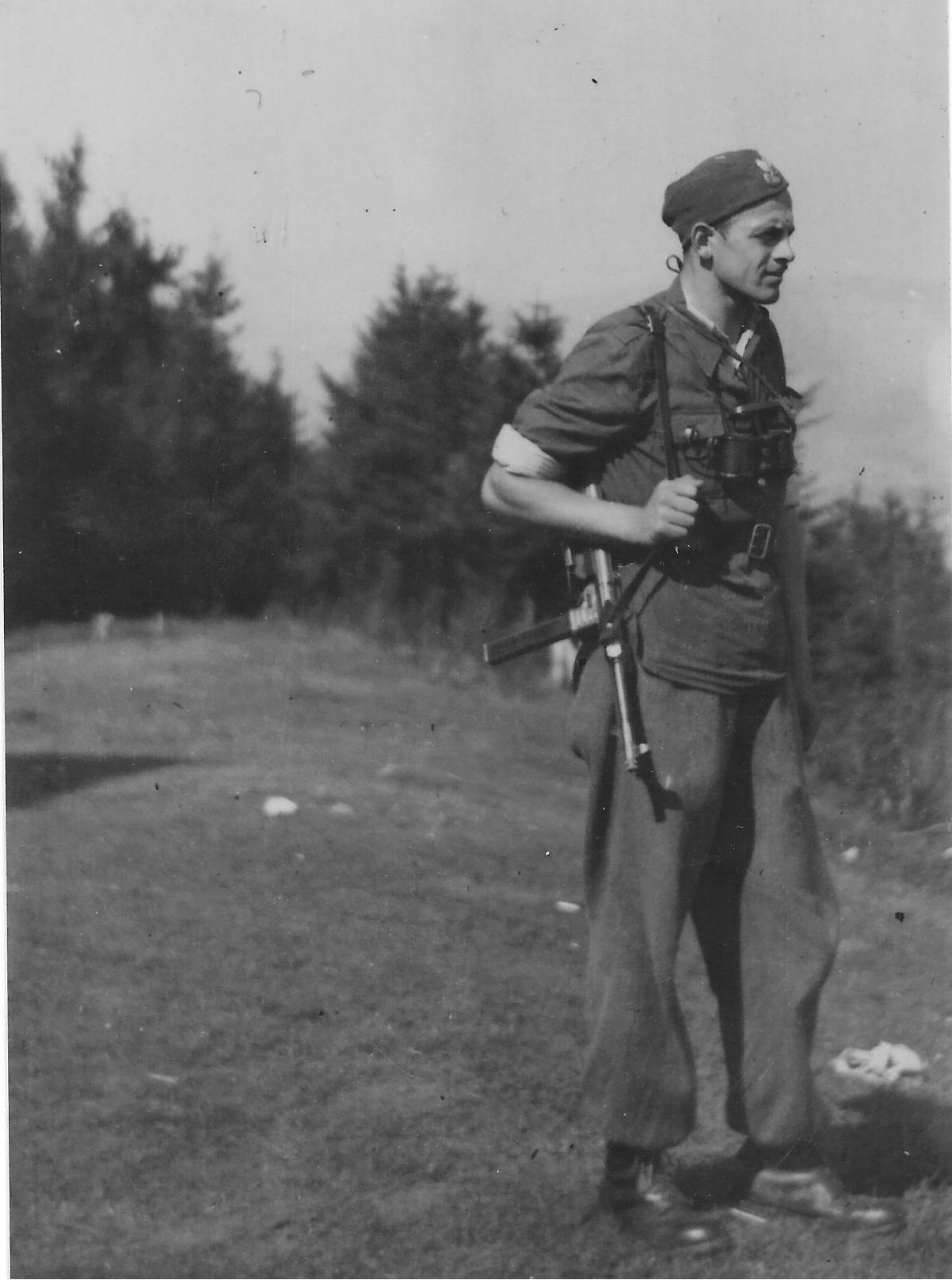
|
|
Dr. Rudek Bednarczyk "Szum"
Photo Courtesy:
Estate of Józef Węglarz "Mały"

|
|
Rifleman Kotarbę "Jaskółka" (a professional army chef) was in charge of feeding the unit.
An outpost in Porębie Wielka delivered about 30 two-kilogram loafs of bread weekly.
Meat was either purchased or confiscated from German Army forced deliveries.
Sugar, cheese, butter and canned food came from a food-processing plant in Tymbark (inż. Marek).
Clothing came from hidden Polish army uniforms from 1939 and also taken from the Germans as a result of unit operations.
From the first aerial drop the unit received battledress clothes, blankets, shoes, arms,
ammunition and U.S. Dollars. Most unit members got their uniform and a machine pistol "Sten".
The unit got an anti-tank weapon - "Piat".
The main source of provisions still remained goods taken from the
German-bound transports: flour, fats, vodka, cigarettes and tobacco.
"MSZYCA" MEDICAL DEPARTMENT
At first the man in charge was a Platoon Leader Tadeusz Wacławik "Długi".
Dr. Rudek Bednarczyk "Szum" took over as soon as he joined the "MSZYCA" unit. He had two trained medics helping him. If anyone got wounded they received first aid.
All local physicians supplied the unit with medications but the most came through Dr. Jezierski - Chief of Staff of the Rabka Hospital. Dr. Tadeusz Ptak of Tymbark was another physician "on duty" in case of emergency.
The underground had a network of hide-outs usually used by those hiding from the Gestapo's most wanted list so these hide-outs doubled as sick bays when needed - to provide a temporary shelter for a wounded soldier.
Any non-emergency illnesses had to be taken care of by the sick person themselves (usually their families) since the unit did not have the ability to maintain its own military hospital.
"MSZYCA" JUDICIAL DEPARTMENT
The Department consisted of two smaller sections:
1 - Offences,
and
2- Robberies.
Members: Władysław Kępa "Ferdek", and Stanisław Janas "Wilk".
The major task of this Department was to investigate and to report the findings (opinions) to the Inspectorate. The latter made the ruling and its decision was final.
In cases of local spies or collaborators the penalties were flogging for male offenders and head- shaving for females but also confiscating their possessions. cattle, etc.
A separate entity in this department was the Intelligence Section and as such it remained in contact with all the outposts in all towns and villages. Their main job was to keep abreast of any administrative
or police related moves of the authorities including contingents and quotas. Another key task was maintaining and recruiting informants in the ranks of the local (Navy-Blue) Police.
"MSZYCA" PASTORAL DEPARTMENT
Father Józef Kochan "Krzysztof" was the chaplain, serving both the Roman-Catholic and the Jewish denominations. He was with the unit in all operations. He celebrated mass every Sunday.
His presence boosted unit morale and spiritual well being. He was also a counsel to the unit's judicial department. Father was very dedicated to the unit's cause.
He was always righteous and very professional - even in situations which to some were sometimes quite funny: as a very handsome man he resisted many advances from the fair sex when the unit stayed in places where
his profession was not revealed to the uninitiated. His assistant was a young soldier Tadeusz Michalski "Śmiały", later assuming the position of the Home Army Chaplain.
"MSZYCA" EXTERNAL ACTIVITIES
The units activities were quite diversified and can be divided into several categories. (Further items may be added by consulting the archives of the Inspectorate).
- Military operations - open armed confrontations with the enemy.
- Diversion and sabotage.
- Policing against criminal activities.
- Upholding the patriotic spirit in the region.
- Informing the proper Polish authorities (via the Inspectorate).
- Security of persons or objects important to the spirit of the Resistance.
- Protecting national property, relief of confiscated goods (grains, cattle).
- Fighting the forced labour.
Partial List of QUARTERS AND PLACES OF STAY OF SECTION "MSZYCA". JANUARY 1944- JANUARY 1945
- PODOBIN Adamczyki Settlement
- PODOBIN Moskaly Settlement
- OLSZOWKA Lipowka, Zapala Household
- RABA NIZNA Maslowiec Household
- LUBON WIELKI Mountain Lodge
- LUBOGOSZCZ Old YMCA Camp
- KASINKA MALA Labuzy Settlement
......... others - LIST needs updating.......
"MSZYCA" OPERATIONS-1944
1. "MSZYCA" OPERATION APPREHENSION OF A GESTAPO CONFIDANT IN TYMBARK - FEBRUARY 1944
"Adam" was given orders to apprehend a German confidant in Tymbark.
She was an attractive woman sent into "MSZYCA" territory to gain access and collect information about our organization.
She contacted the local Fruit Processing Co-Op, which was supplying goods to partisan units operating there.
She begun contacting individuals, probing in this way who may have been a member of the underground.
Her job to infiltrate the underground was meant to prepare for large-scale arrests.
She got to one of the Cadets who lived in Dobra and worked in Tymbark.
"Adam" realized that the act of apprehending needed some improvisation and decided that he and Józef Węglarz "Mały" would take care of this together.
"Adam" trusted "Mały" and as his adjutant who also often worked as his personal security detail serving as his bodyguard on several occasions.
When they arrived in Dobra, "Adam" contacted the above-mentioned Cadet. "Adam" explained the goal of the mission and instructed the Cadet not to come to work but instead to ask this girl out on a "date" in Tymbark.
His instructions were to take her for a walk to the river Lososina around 7 PM. There was a footbridge leading towards Dobra - a secluded place surrounded by a thick bush.
The Cadet said that the woman was a daughter of a Polish officer a major who after 1939 was a POW. She lived in Krakow with her mother in rather difficult conditions.
To some extend the Cadet was not convinced about her role as an agent nor was he sure about "Adam's" intentions. After all "Adam" was wearing a black coat resembling one worn by Gestapo and carried a VIS pistol.
"Mały" was also dressed in civilian clothes and was armed with a Parabellum pistol and a hand grenade. Finally the Cadet agreed to cooperate. On their way to the arranged spot "Adam" and "Mały" stopped by a local
bar for a stiff drink and from the bartender they learnt that two Gestapo trucks full of men had just arrived in Tymbark. Nevertheless they still went on to carry out their plan but soon realized that it could be them
falling into a trap. After all, the woman could have been double-crossing them. With this in mind they let the two "love birds" pass by and made sure that no one was following them.
"Adam" and "Mały" approached them from behind. "Adam" ordered them to put their hands up and introduced himself as an officer of the Gestapo. She seemed undisturbed by that and did not show any fear hearing the
German language. Suddenly, two German cars appeared, and "Adam" ordered: "On the ground!" - this time in Polish and this is when the girl asked: "Why are you scared of the Germans?" "Adam" replied:
"We are not the Gestapo - they are." This is when she realized that the Gestapo was not arresting her date, but that she was the captive in the hands of the underground. She moaned:
"My God, you are the boys of the forest, aren't you?"
After we searched her purse our suspicions were confirmed - she carried a small calibre revolver. Quickly we got back under way to Dobra.
We delivered the agent to the hands of the Inspectorat via the Communications Section commanded by Lt. Jan Cieslak "Maciej" who later became the adjutant to Mjr. Adam Stabrawa "Borowy" -
the commanding officer of our Regiment (1PSP -AK).
2. "MSZYCA" OPERATION RAID ON A LUBIEN -SKOMIELNA-BIALA ROAD
In the night of June 4/5, 1944 the unit received an airdrop at Mogielnica and after a short rest at the Luben Wielki "Adam" sent a patrol to set up an ambush on the Lubien - Skomielna road.
The target was either a single military vehicle or a transport. Members of the "MSZYCA" unit hid in the bushes about the ditch and observed the highway waiting for an opportunity to strike.
Their weapons consisted of "Mały's" Sten gun (from the airdrop) and several rifles.
A motorcycle with a sidecar was spotted. The crew was the driver plus a gunman in the sidecar.
The partisans opened sporadic fire, hit the driver and the motorcycle ended up in the ditch not far from the ambush point.
They were about to take the German's weapons when a convoy appeared quickly - when it was realized that the motorcycle was the front guard of the convoy.
The Germans opened heavy but chaotic fire from the other side of the road - after all they were not exactly sure where the attack came from.
The ambush position was chosen perfectly for an assault as well as for a retreat. The partisans disengaged and moved out without any losses.
Photo: "MSZYCA" Unit Partisans after receiving an Airdrop in Mogielnica Summer 1944
Photo Courtesy:
Estate of Józef Węglarz "Mały"
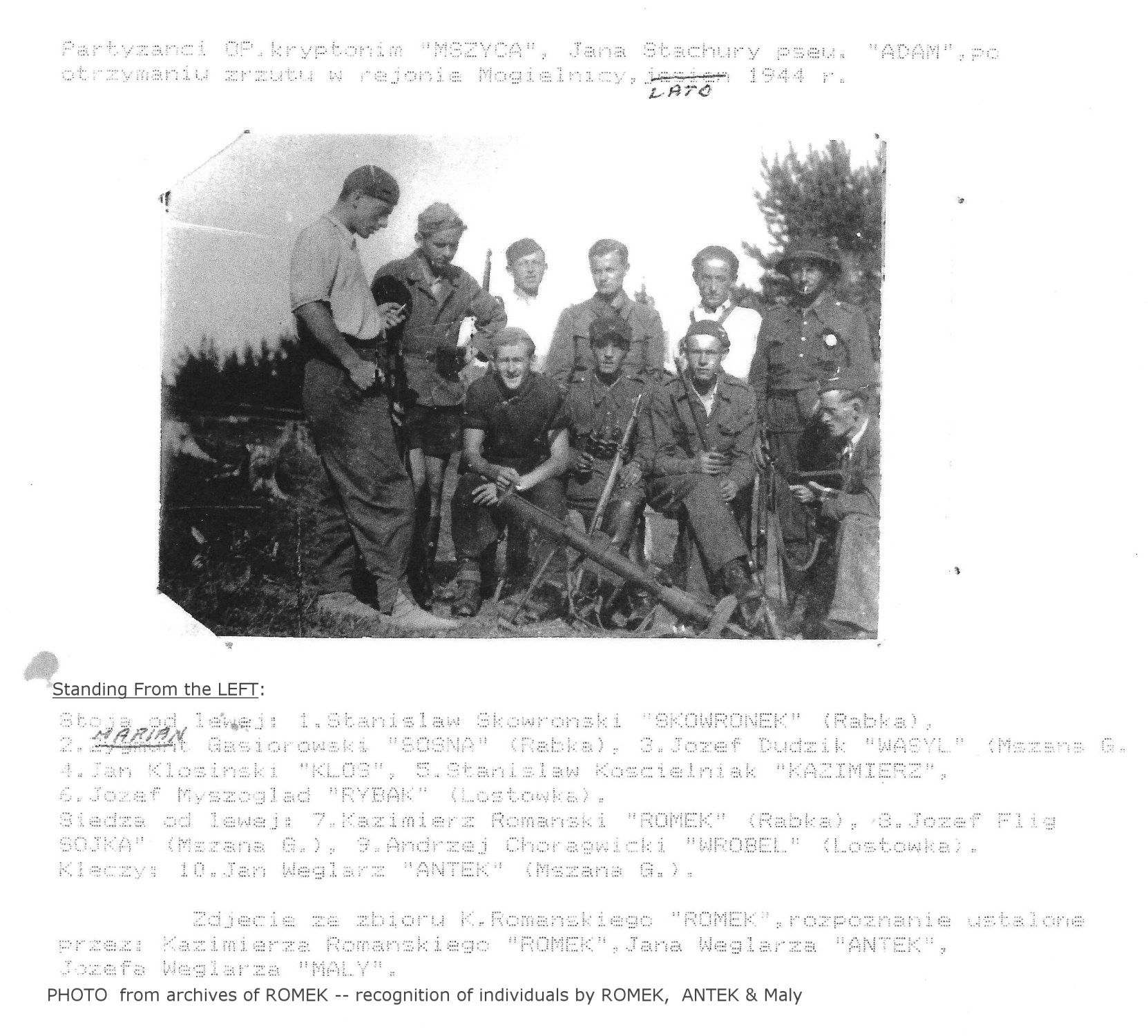
|
"MSZYCA" 1944 Photo 71: Partisans Waiting For Airdrop, "Mały" 2nd from right
Photo Courtesy:
Estate of Józef Węglarz "Mały"
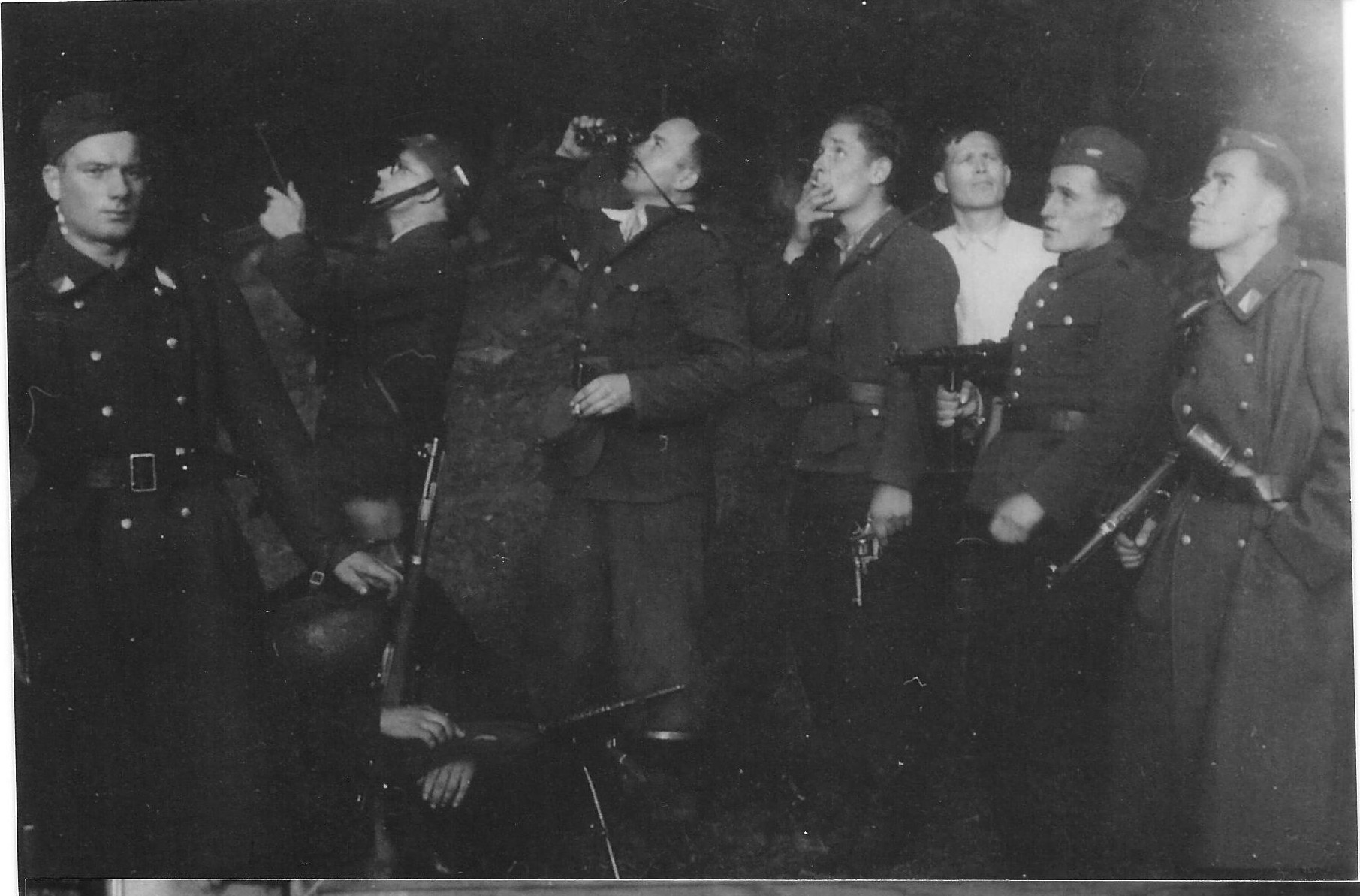
|
|
"MSZYCA" 1944 Photo 68: 4 NN
Photo Courtesy:
Estate of Józef Węglarz "Mały"

|
|
3. "MSZYCA" OPERATION ASSAULT ON A "SLOŃCE" VILLA IN ZARYTE - JUNE 1944
The operation began around midnight.
Its goal was to disarm two Germans - not sure of their rank or designation.
The whole "MSZYCA" unit took positions on a hill overlooking the Raba River on the Olszówka side. According to the intelligence the Germans occupied two separate rooms upstairs and the doors
to the rooms and to the main entrance were not locked.
"Adam" appointed "Tygrys" and "Mały" to do the disarming.
The secondary (cover) group consisted of "Bocian", "Indyk", "Dzięcioł", and "Jeleń".
The last two kept eye contact with "Adam's" disarming team the whole time when they gained the entry and got to the second floor as quietly as possible.
Unfortunately, the doors were locked and both Germans now awakened opened fire through the closed doors.
"Mały" fired a few short bursts trying to hit and break the locks but the doors were also barricaded from the inside.
Then "Mały" noticed "Jeleń" down on the stairs in front of the first room in an unnatural position. Mały concluded that he was wounded. "Dzięcioł" and "Bocian" carried him out - still under fire.
It turned out that instead of crawling down the stairs "Jeleń" had stood up and turned his back to the door trying to withdraw, when the bullets penetrated the door and hit him.
To continue the assault was futile since the element of surprise was lost and a man was down.
The unit retreated across the river.
"Jeleń" was in critical condition; the bullet entered his back and severely damaged his abdomen. Only an immediate surgery could have saved him and that option was unfortunately not available at that time.
His agony was very painful but he could not be helped even with that. He was buried in a nearby grove next to a mountain creek.
After the war he received a proper burial with military honours in the parish cemetery in Olszowka. "Mały" was there, then, saying good-bye with many of his comrades and a large number of the locals.
4. "MSZYCA" OPERATION DISARMING OF A UKRAINIAN POLICE COMMANDANT IN LOSTÓWKA AUGUST 4, 1944
During a night patrol around Mszana Goma and Lostowka a message from the local outpost was received by the "MSZYCA" unit informing them that two armed members of the Ukrainian police
(one of them a high-ranked officer) were hiding in the settlement of Olszowka (across from Krupy settlement) in Mszana Goma. They were fleeing the incoming front.
The decision was made to disarm them. The soldiers on patrol were "Bocian", Dzięcioł", "Sojka", "Wrobel", and "Mały",
The door was open. The partisans entered the room and found a man and a woman sleeping on the floor. Awakened by a flashlight shining in his face, the man reached under his pillow for a gun.
He was immediately pinned down and disarmed. Documents found on him confirmed his rank and position. He was taken away for further investigation at the headquarters.
In crossing the Mszanka River on the way back to headquarters, the captured officer jumped from the footbridge into the water. Someone fired a gun and killed him on the spot.
Since dawn was upon them they did not even have the time to take care of the body and it was left to float away.
August 1944 Photo: "MSZYCA" Partisan Soldiers Waiting for Airdrop to MOGIELNICA - which did not occur as Planes Flew on to Warsaw.
Standing from Left to Right: 1. Marian Gąsiorowski "Sosna�, 2. Jan Węglarz "Antek� (small portion of head seen), 3. Józef Myszogląd "Rybak�, 4. Józef Dudzik "Wasyl�,
5. Stanisław Kościelniak "Kazek�, 6. Adam Hubiszta "Łoś�, 7. Andrzej Chorągwicki "Waśko�, 8. Stanisław Skowroński "Skowronek�
Seated From the Left: 9. Kazimierz Romański "Romek�, 10. Józef Węglarz "Mały�, 11. Józef Flig "Sójka�
Photo Courtesy:
Estate of Józef Węglarz "Mały"

|
|
5. "MSZYCA" OPERATION ASSAULT ON A CONVOY (KASINA-WIELKA- MSZANA-DOLNA ROAD) AUGUST 11, 1944
This operation took place on the road from Dobra to Mszana Dolna around midnight.
The entire unit came from Wilczyce down to the intersection with the road to Kasina. The road runs parallel to the railway there and positions were taken at the crossroads.
From the direction of Gruszowiec incoming headlights of the convoy were noticed. After we got the confirmation from the unit's "eyes" up the road, "Adam" signaled to open fire.
The unit hit them with all they had but the convoy was never brought to a halt and managed to continue towards Mszana Dolna.
As a result the Germans had four killed and nine wounded.
6. "MSZYCA" OPERATION ACTION IN KASINKA-MALA ON A GROUP OF UKRAINIANS AUGUST 12, 1944
The next night the unit was marching towards Lubien to set up another ambush the following day.
The Ukrainians made camp on the S-W slope of the Lubogoszcz by the creek.
"Adam" decided to teach them a lesson - not to be feeling at home on Polish turf.
The Ukrainians camp was surrounded and the partisans opened fire. The Ukrainians fired back and gunfire was exchanged briefly.
To gain other objectives required, however, more time and preparation.
Thus the partisans disengaged and continued the march to reach their major goal - a more important one -the site of our tomorrow's operation on the road to Lubien.
7. "MSZYCA" OPERATION AMBUSH ON A LUBIEŃ - MSZANA-DOLNA ROAD AUGUST 13 1944
This was one of the few operations carried out in the broad daylight.
On the road in Lubień on the boundary of Kasinka Mala, "Adam" selected a spot on a steep tree covered slope of Szczebel Maly.
The line of trees touches the slightly curved road there. The objective was to intercept and disable a single military vehicle.
The signal was to come from a tree top where our eye could determine whether a target was a single vehicle without additional security.
The chances did not look good against a convoy, thus they let a few of them pass by until a green light was given - a single truck was coming from the direction of ubień.
The ambush team opened fire causing the truck to hit the ditch on the other side of the road. However, soon thereafter several trucks with soldiers arrived and engaged the partisans.
Under fire they withdrew along the steep slope and through Teczyn soon reaching a lodge on Lubon Wielki.
The Germans had several killed and wounded in this ambush so for the future they cleared the trees from the entire slope and posted traffic signs warning against partisan activities in this and other locations
which they deemed high risk.
The signs read" Achtung! Banditen - Lebens Gefahr." "Warning! Bandits- Grave Danger."
8. "MSZYCA" OPERATION RAID ON A RESTAURANT IN RABKA (TOURIST STATION TURBACZ ) - SUMMER 1944
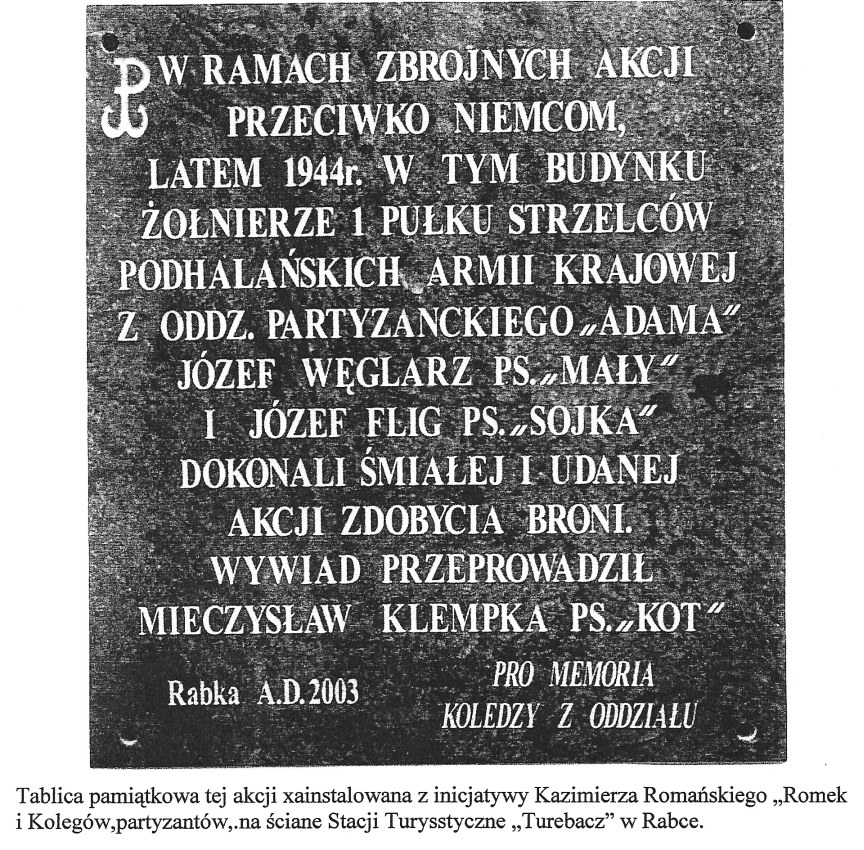
1944 Photo: Józef Węglarz "Mały" and Józef Flig "Sójka"
Photo Courtesy:
Estate of Józef Węglarz "Mały"

|
|
The lodge on Luboń Wielki was the "MSZYCA" unit's primary campsite summer of 1944.
Its peak was 1,023 m above sea level and dominated by cities such as Rabica and Mszana Dolna. Covered in thick forest it was a natural place for the "MSZYCA" quarters and base from which they set out from for many operations.
For this operartion, Mieczyslaw Klempka "Kot" provided the intelligence. His father operated a tourist station "Turbacz" and informed the unit that a high ranking German bureaucrat was fleeing eastern Poland
ahead of the moving front lines. He was staying there accompanied by two women - possibly a wife and a secretary.
"Adam" ordered "Kot" to provide all necessary details such as floor plans, access routes, exits, weapons, and their itinerary. He did a great job and thus the partisans knew that the German had a machine pistol,
a revolver and ammunition hidden behind a cupboard.
Since it was another day raid, men from outside of Rabka had to be used to avoid a chance of being recognized.
Józef Węglarz "Mały" volunteered being an outsider yet he knew the town quite well. Józef Flig "Sojka" volunteered as well. This was a good team as they'd already had a few successful runs - just to mention the raid on a sawmill
in Rytro in 1943 while in their old section "Wilk".
The day was sunny and clear and they set out to Rabka wearing civilian clothes and hiding their handguns. They travelled on foot using side roads and crossed the Raba River by a footbridge and from behind the
church where they emerged onto the main street.
Undisturbed, they reached their destination where "Kot" gave the all clear signal.
They quietly got to the second floor took out their pistols and "Mały" knocked on the door.
A woman opened but suddenly she tried to shut it- "Mały" wedged his foot in the closing gap and with his whole body pushed through, overpowering her completely.
The man was not there and "Mały" ordered the two women to lie face down on the floor.
They identified themselves as Polish Home Army soldiers and then pretended to conduct a random search - after all "Kot" and his father needed to remain beyond any suspicion.
Their "random" search resulted in finding a small French "MAAS" machine pistol and a Russian "seven-shooter" behind the cupboard.
They ordered the women to stay down for another 10 minutes and immediately left the room.
"Mały's" long light summer coat was ideal to cover the pistol so they walked onto the street casually but had their weapons ready with the safety off and fingers on the triggers.
According to a Polish saying "More lucky than smart" "Mały" stopped a horse-drawn cab, showed the driver his pistol and ordered him to take them to Zaryte. He did not oppose and quickly they
were getting out of town passing armed German soldiers in the streets. They told the driver to continue to the next intersection and then to return to Rabka and report to the police.
Once across the footbridge they simply jumped off and using the same back roads returning to Luboń checking thoroughly if they were being followed. When they were far enough they took some shots from their
trophy weapons to see if they worked.
The plaque image shown on the right was installed on the wall of the tourist station "Turbacz" in 2003 and remembers this operation.
9. "MSZYCA" OPERATION ACTION ON A BRIDGE ON THE PORABKA RIVER (UNPLANNED). ROAD TO MSZANA� GORNA- SUMMER 1944
"MSZYCA" 1944 Photo 65: 3 NN
Photo Courtesy:
Estate of Józef Węglarz "Mały"

|
Two soldiers of the "Mszyca" unit, Michał Kołodziej "Bocian" and Józef Kołodziejczyk "Dzięciol" encountered two uniformed Germans while on patrol.
They were crossing a bridge on the Porabka River and they met about half way through the bridge, thus turning and walking away was not an option for either side.
Our boys had enough army experience mixed with some cool blood so they ordered the Germans to put their hands up. Instead they reached for their arms. A short battle ensued.
As a result one of the Germans got shot dead the other was wounded and got away in the dark of the night. They returned home with a "Parabellum" pistol.
The unit was afraid that the Germans might react brutally against the civilian population for killing a soldier. Luckily they treated this incident as a crime of passion of a jealous fiancé
since the Germans were returning from a date with some local girls. The girls were later punished by "haircuts".
10. "MSZYCA" OPERATION DISARMING OF A WEHRMACHT SOLDIER. MSZANA-DOLNA - LEŚNA STREET.
SEPTEMBER 26, 1944
Section "Mszyca" was stationed in an old pre-war YMCA camp on the slope of the Lubogoszcz Peak at that time.
The unit got intel that the Germans from their Mszana garrison make frequent walks along the Podlesie Street with local girls of not the best reputation.
The unit wanted to send a strong message that this kind of fraternization would not be tolerated and the objective was also to disarm someone to make the intentions clear.
At this point a bloodless solution was hoped for.
"Mały" led the patrol, wearing a German uniform and had a few volunteers with him. "Mały" carried the "Maas" machine pistol and a "Parabellum" handgun. The spot that they were staking out was located
along the Podlesie Street that runs parallel to a gorge with a stream running down the Lubogoszcz.
"Mały" split the group into two. "Mały" led the first one - with the task to disarm; the other was to disrobe- take the uniform and, especially, the boots.
The unit always needed boots. When they stepped onto the street they noticed some soldiers accompanied by females. The nearest one had a rifle on his right shoulder and a girl under his left arm.
When they closed in "Mały" stepped in front of them and ordered "Hands up". The soldier hesitated when he saw "Mały's" uniform - so "Mały" repeated his order.
The soldier reached for his rifle. "Mały" did not want to alarm the others by shooting him, so he hit him over the head with the butt of the "Maas".
Unfortunately the safety was off, and "Mały's" pistol fired, the German got hit in the left arm, and the ricochet ended up hitting "Wicher" who was standing next to "Mały".
To be exact "Wicher" had a homemade grenade in his pocket and the bullet damaged the firing pin. Fortunately, there was no explosion otherwise all four of the partisans would have been dead.
"Mały" quickly told "Wicher" to throw the grenade into the gorge just in case. It still did not explode but the other Germans now alarmed by the single shot opened a sporadic fire in the direction of the partisans.
They took the rifle from the wounded man and fled down the gorge. To confuse any pursuit they took a long detour to get to their camp.
The next day Fr. "Krzysztof" celebrated a special Thanksgiving mass thanking God for his providence.
Photo: "Mszyca" Lubogoszcz YMCA Camp 1944 , "Adam", "Ferdek", "Skowronek", "Wicher" and others
Photos Courtesy: Estate of Józef Węglarz "Mały"

|
|
1944 "MSZYCA" Photo 28a: Józef Węglarz ps Mały at LUBOGOSZCZ YMCA Camp
Photo Courtesy:
Estate of Józef Węglarz "Mały"

|
|
"MSZYCA" 1944 Photo 53: Hauling Water Thought To Be In LUBOGOSZCZ YMCA Camp (Kybik)
Photo Courtesy:
Estate of Józef Węglarz "Mały"

|
|
1944 "MSZYCA" YMCA Lubogoszcz Camp Photo 90: 1. Andrzej Chorągwicki "Wróbel", 2. NN, 3. Jan Załubski "Hiszpan", 4. Stanisław Luber "Indyk"
Photo Courtesy:
Estate of Józef Węglarz "Mały"

|
|
"MSZYCA" 1944 Photo 78 Lining Up For Soup In Camp
Photo Courtesy:
Estate of Józef Węglarz "Mały"
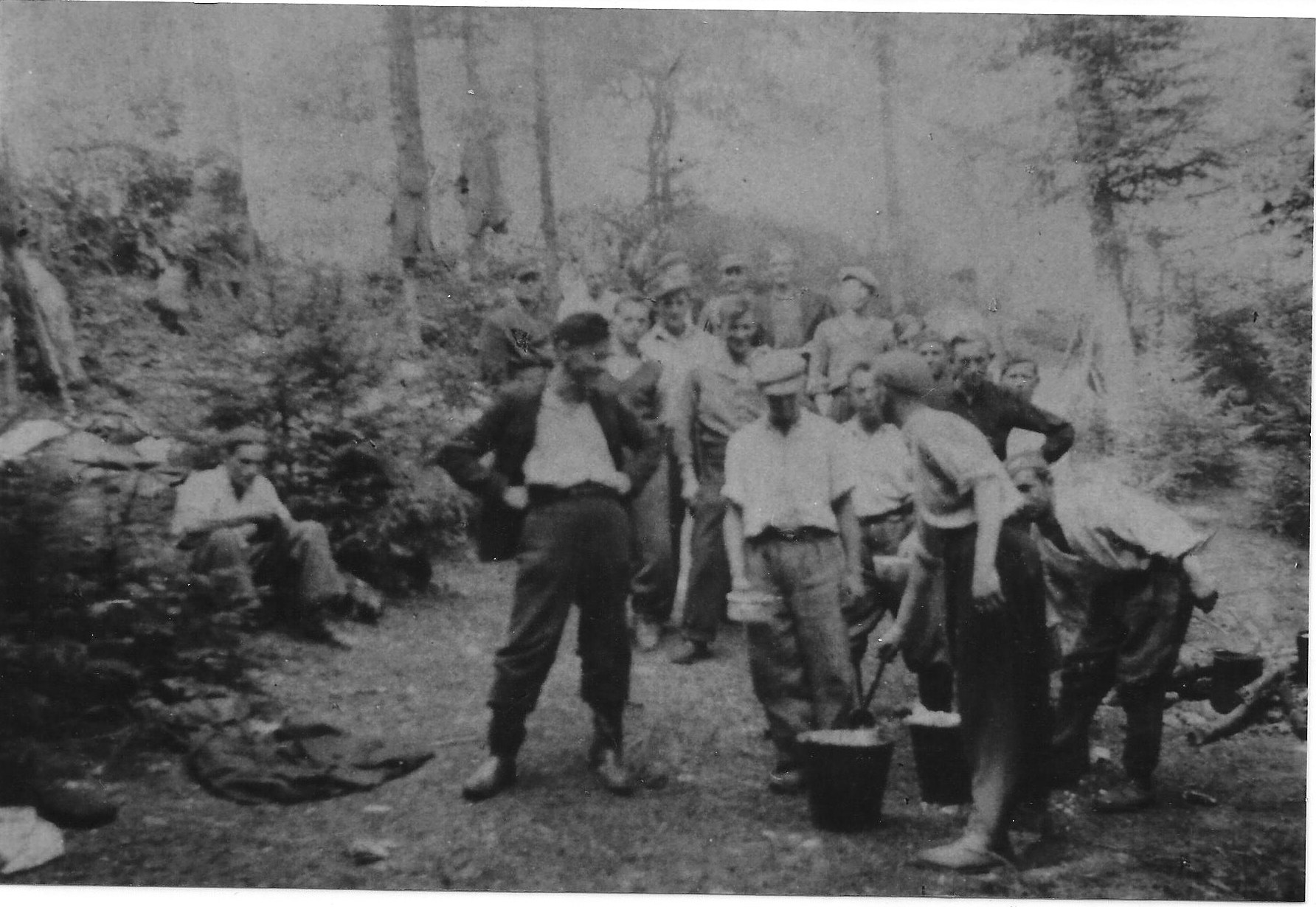
|
|
"MSZYCA" 1944 Photo 69: 7 Partisans In Camp
Photo Courtesy:
Estate of Józef Węglarz "Mały"

|
|
"MSZYCA" 1944 Photo 77 YMCA Lubogoszcz Mountain: Left to Right:
1. Stanisław Janas "Wilk", 2. Józef Węglarz "Mały" (with machine gun & camera), 3. Jan Molik "Goliat", 4. Tadeusz Wacławik "Długi",
5. Stanisław Wyka "Boa"
Photo Courtesy:
Estate of Józef Węglarz "Mały"
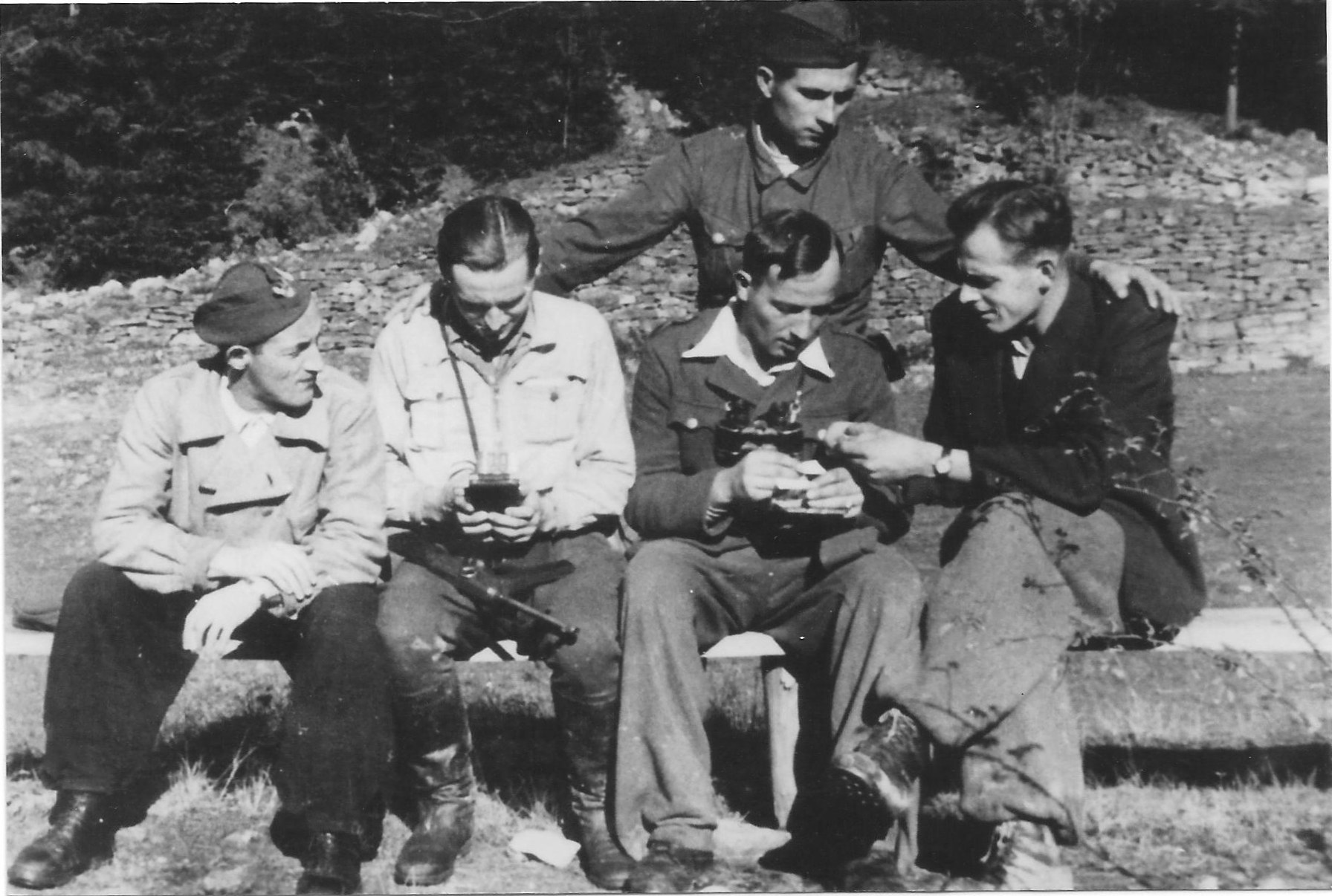
|
|
"MSZYCA" 1944 Photo 72: Partisans Guarding Camp
Photo Courtesy:
Estate of Józef Węglarz "Mały"

|
|
11. "MSZYCA" OPERATION RAID ON WYSOKA NEAR NOWY-SACZ SECOND HALF OF OCTOBER 1944
Photos: Stanisław Luber "Indyk"
& Jan Zalubski "Hiszpan"
Photos Courtesy:
Estate of Józef Węglarz "Mały"

|

Section "Mszyca" was still at the old YMCA camp in the later part of October 1944.
Word was received that in Wysoka near Nowy Sacz there was a small Wehrmacht unit supervising digging out trenches.
Among them some Poles from Silesia - drafted by the Germans - now allegedly wanting to come to our side and join our unit with their weapons.
"Mały" got the order to make contact. "Mały" had two helpers who volunteered for this mission - "Hiszpan" and "Indyk" - very much respected and brave soldiers.
Dressed in civilian clothes they travelled light carrying small caliber handguns, a few grenades and the "Maas" machine pistol. They marched to Mogielnica where they stopped for the night at a camp of �Andrzej's" unit.
They reached their destination the next evening but there was no one waiting for them there. They met a local contact in a nearby settlement - had a meal and a sleep.
The next day they returned to the assigned meeting place this time using caution since they smelled something was wrong.
"Hiszpan" volunteered to be the one-man reconnaissance.
"Mały" comments:
"He moved ahead of us and followed trying to keep a visual contact in a very thick bush. Suddenly, I noticed a silhouette of a man
about to fire a shot. In fact it was an ambush and we saw "Hiszpan" fall. We opened fire but our small calibre weapons were no good to continue an assault. We were surrounded but we broke free from the trap.
We stuck around long enough to establish the fact that "Hiszpan" was dead. Since his revolver was a Russian made, I guess the Germans must have concluded that he was a Russian partisan.
This is how we lost one of the bravest men I knew - Jan Zalubski "Hiszpan". In my opinion our intelligence could have been more thorough in working out the probabilities of an ambush. "
12. "MSZYCA" OPERATION RAID ON AN MSZANA-DOLNA- RABKA ROAD NEAR SETTLEMENT MARKL OCTOBER 25, 1944
A few days after the loss of "Hiszpan" the unti went on another mission.
The unit stayed on Mount Glisne enjoying the hospitality of the Daszk�ewicz family in their settlement. ("Ali" was their son).
Information was received that the German Forstschutz (Forest Guard) was going to deliver a large amount of timber to the saw mill in Mszana Dolna.
"Mały" was sitting this one out to protect his family in case of being recognized by any witnesses during a day mission.
This is a story told by Kazimierz Romanski "Romek"- one of the participants.
" The other members of the patrol were "Dlugi","Skowronek",and, "Sosna" under the command of "Indyk".
We had to put on civilian clothes again and hide the "Maas" pistol and our handguns. We also carried shovels and other tools so we looked like a road maintenance crew.
From Glisne we got down to our destination via the bridge on the Raba River about noon and waited along the road for the Germans.
"Dlugi" stayed back to protect his identity since everyone knew him in that village.
When we spotted the Germans they had already unloaded the timber and since they were returning they came at us from the opposite direction.
From a tight group we stretched along the road. The carriages had local drivers from Raba Nizna and there were five German soldiers among them.
We took our weapons out and ordered them to give themselves up. We took five brand new rifles from them but before we could search them a car approached quickly.
One German soldier took a chance and jumped into a ditch, took out a "Parabellum" and started shooting us. The others followed and "Skowronek" and "Sosna" withdrew.
"Indyk" and I ("Romek") ran towards a nearby railway track. We returned fire. Then we ran down an open slope some 15 meters neck-in-neck.
Suddenly I felt heat on my face. I saw "Indyk" fall down with a moan. He was dead before he hit the ground - the bullet took out a piece of his skull. I took his rifle and pistol and ran up the slope shooting back.
I stopped when I was out of their bullets' range. I found "Skowronek" and "Sosna" and felt better instantly.
We jumped the so-called Olszyny, then Mszanka and made it to Mount Spytkowa. At night we took a detour and returned to our base at Okragla where I reported to "Adam" the death of our man.
I recall "Adam" responded "Now go and wash up". My face and clothes were covered with blood and brain fragments.
All the Germans wore a V on their sleeves, which indicates the rank of non-commission officers of the Wehrmacht. "
13. "MSZYCA" OPERATION DISARMING OF WEHRMACHT SOLDIERS TRANSPORTING WOOD FROM LUBON� WIELKI OCTOBER 28, 1944
"MSZYCA" 1944 Photo 64: 3 NN
Photo Courtesy:
Estate of Józef Węglarz "Mały"
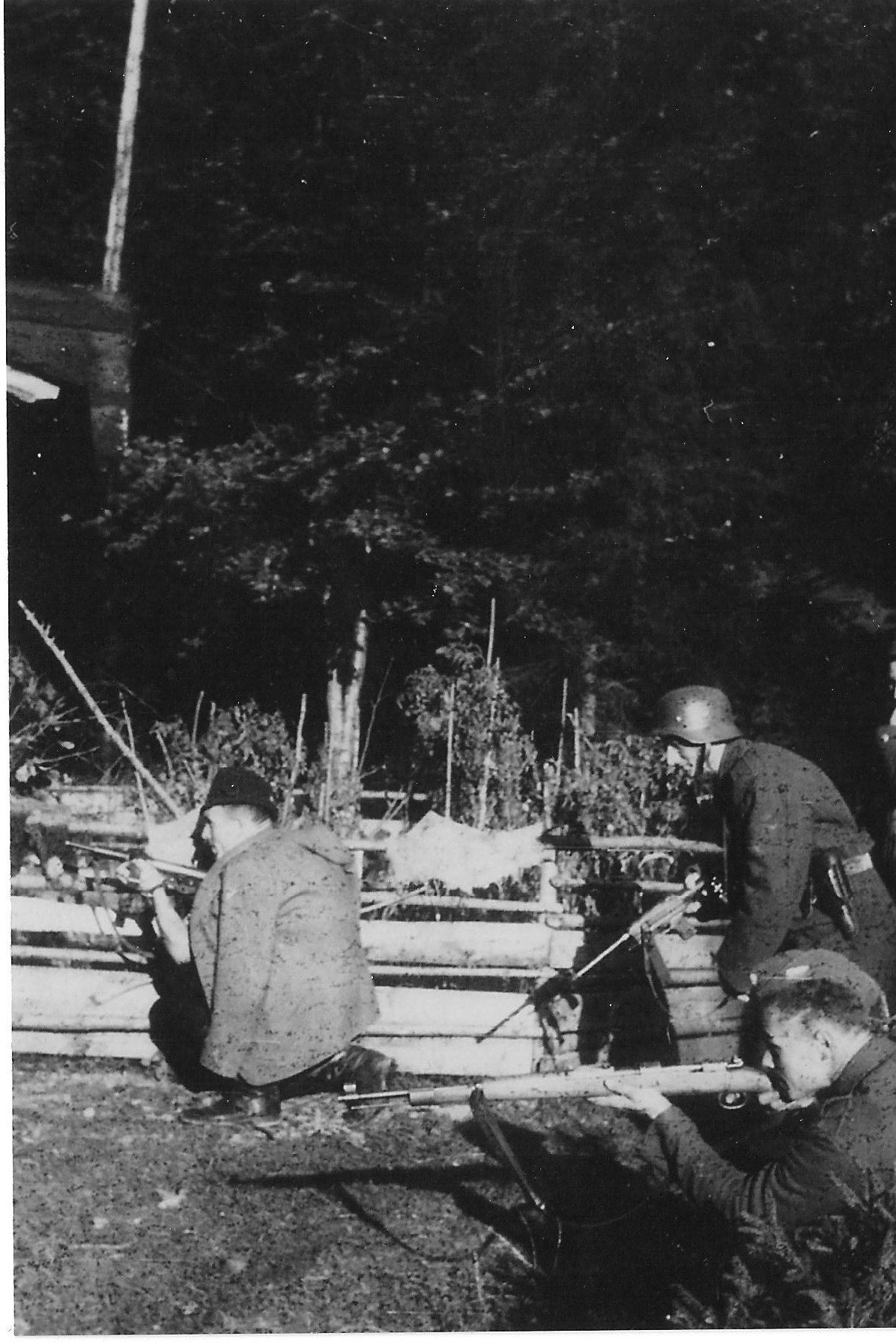
|
|
"MSZYCA" 1944 Photo 66: 4 NN
Photo Courtesy:
Estate of Józef Węglarz "Mały"
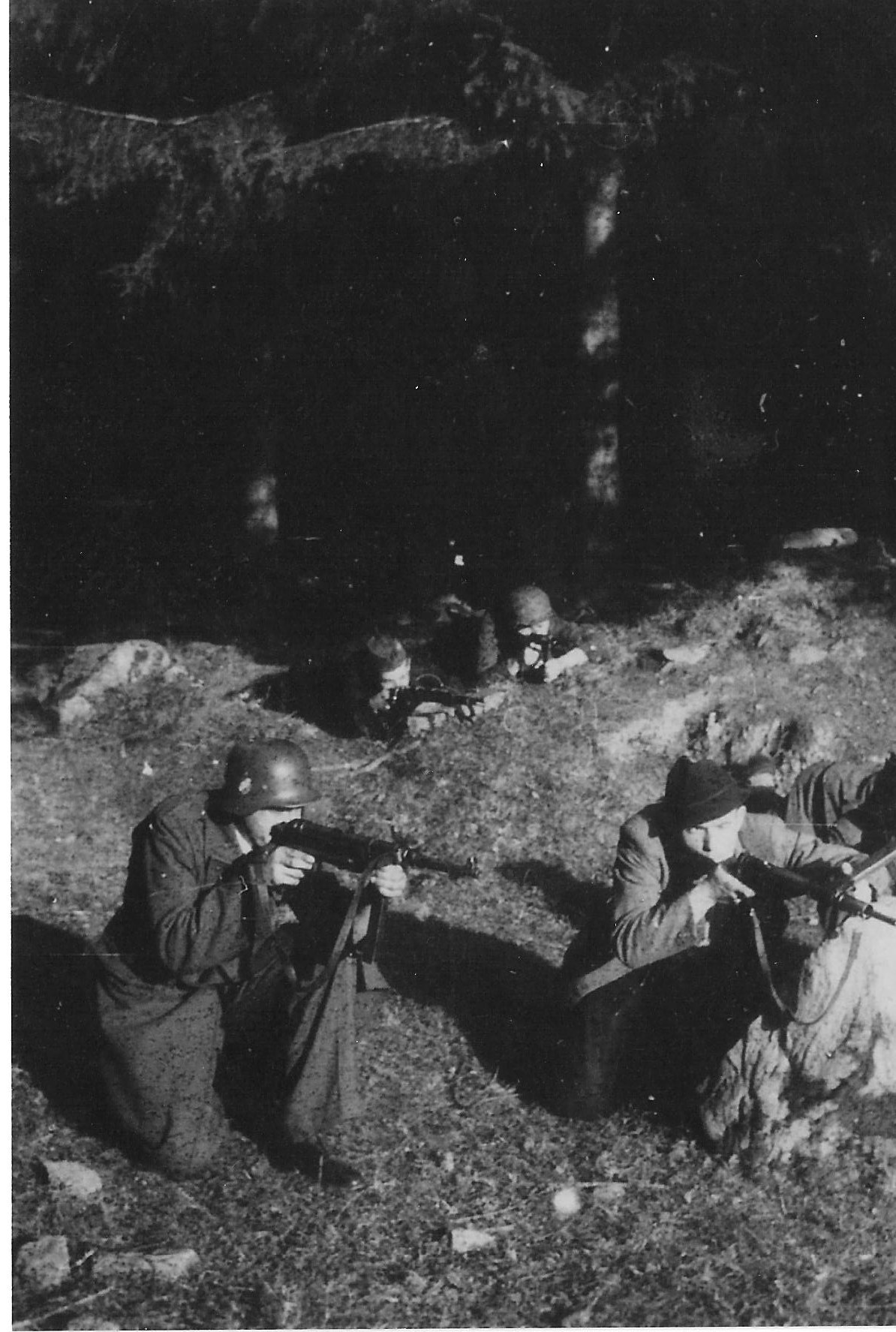
|
|
At the "MSZYCA" Shelter on Luboń Standing Left to Right:
Kazimierz Grzesiak "Grot�, NN, Władysław Rogowiec "Witold�, Roman Medwicz "Morski�, Edward Palarczyk "Jeleń�
Photo Courtesy: Kamil Romański
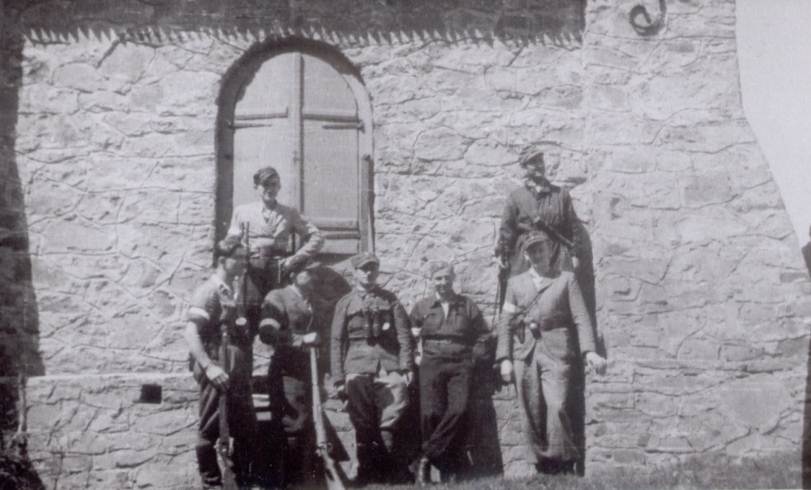
|
|
One afternoon while stationing on Lubon Wielki a 10 year-old son of the Kaleciaks, our hosts came to the lodge and told us that less than a kilometer away a group of German soldiers
loaded wood on five carts.
"Adam" quickly readied the unit. With his second in command Lt."Dick" they improvised a plan to take the Germans by surprise.
We were to intercept them on their way back and disarm them.
"Adam" led a group staking both sides of the road, whereas "Dick" had his men closing the escape route.
"Mały's" position was right across from "Adam" and his task was to overtake the first cart.
When we got the signal, we jumped out calling the Germans to give up.
All but one immediately lay on the ground, we took some shots at the escapee but he ran away. The others surrendered too, although one started shooting but one short burst of our machine pistol pinned him and
wounded him in the neck.
"Adam" ordered to cease fire and we proceeded to disarm and to search the prisoners. We collected one machine pistol "Schmeiser", ten rifles, revolvers, grenades, ammunition blankets and some food.
Finally, we took their uniforms leaving them dressed only in their underwear.
Meantime our medic, Rudek Bednarczyk "Szum", tended to the wounded German, stopped the bleeding and placed him on the cart and let them all leave in the direction of Zaryte and Rabka.
Later we learnt that they became a laughing stock upon their return - I wouldn't doubt that they were sent to the Eastern Front.
We also took four of their six horses.
In conclusion we disarmed 10 soldiers (one escaped but without his rifle). Two of them were willing to join our unit - they were the Wlasov Army soldiers.
"Adam" denied their request but advised them to go to the Gorce Mountains to look for some Soviet partisan groups operating there. We achieved a double success. First, we taught the Germans a lesson.
Second, we boosted the morale of the locals particularly in Rabka where the Germans were stationed.
14. "MSZYCA" OPERATION KILLING OF AN SS-STURMSCHARFUHRER OTTO JUNG MSZANA-DOLNA. Oct. 29, 1944
How the Gestapo torched our home. (A story by Mieczyslaw Daszkiewicz "Ali").
On Sunday Oct. 29, 1944 in the late afternoon our entire unit came down from the old YMCA camp on Lubogoszcz to stay at "Mały's" parents' farm and the Pustelnik's family
farm located under the Okragla Mountain.
The evening was warm and beautiful and nothing forecast the change of weather. The next morning we got about 10 cm of wet snow - the first snow that year!
After the morning call and breakfast we were sitting in our dining room playing bridge and waiting for lunch. From his seat "Mały" had a view of our old orchard through a window. At 11:30 he saw a few of our boys
running fast towards the hedge and then we heard a few gunshots.
"Dzieciol" was running first, shooting from the hip from his "MP" (machine pistol). "Kmicic", the chief was just behind him with a pistol in his hand, next to him "Cien" was running and shooting from his "Sten".
Rushing a few steps behind were others: "Kora", "Romek", "Maly", and "Bocian".
We grabbed our arms and jumped outside. There he was in the corner by the hedge, lying dead, the Chief of Gestapo from Mszana Dolna in his SD uniform, our boys standing over his body.
Then we spotted about 300 meters from us another Gestapo man running up Mount Mala to hide in a pine grove. Someone took aim and fired a few times but missed.
On the road by the blacksmith's shop, the driver who brought them there, (Jan Znachowski) cracked his whip and galloped away in the direction of Mszana. It all took just a few minutes.
"Adam" very calmly listened to the nervous rapport of the chief and the others - he always maintained a stoic calm. Then he put the whole section on alert, sent a five-man patrol to Mszana and gave the order
to bury the Gestapo officer away from any buildings after taking his weapons and documents.
According to eyewitnesses "Kora" was on guard duty and spotted the Germans approaching our premises. He made the alarm call and the boys unaware of the situation opened fire just as they saw the Germans come closer.
After what happened we knew that in a few hours the Germans were going to return with vengeance.
"Adam" granted "Mały" a leave and allowed him take a few guys to help his parents with packing up. Another group assisted Mr. and Mrs. Pustelnik in moving their possessions to a temporary shelter in the forest.
Some two hours later our patrol returned painting a rather bleak picture. More than a dozen trucks full of soldiers arrived to take part in what they called a disciplinary - pacifying expedition.
They walked towards Okragla using three separate routes. There was no time to waste. A few suitcases were taken along with two cows and as fast as they could they ran away. The rest of the livestock was left behind.
Through the forest, up a mountain, along a stream they moved towards Glisne. Along the hilltop by the border of Tenczyn "Mały's" parents made it to the farm of Maria and Franciszek Karpierz.
Risking their lives the hosts gave "Mały's" parents shelter.
"Mały" got back to the unit which was now also on the move. Via Glisne and along the border of Tenczyn they entered the forest at Lubon. The Pustelnik family, the other evacuees, found shelter at the Gil household
at the base of Lubon. It was their son-in-law Jozef Gizman "Zar", P. Eng. who escorted them and joined the "MSZYCA" unit there.
About 5 PM the sky above the Okragla got very bright. In fact it was so bright that at the foot of Lubon, some 2 km away they were lit like in daylight - except it was red in colour.
They could not see the fire itself. The body of Okragla was screening their view. But they knew that it was their livelihood going up in flames. They got a confirmation from a patrol that the soldiers and the
Gestapo burnt down our buildings after taking all that they could steal: two pigs, over thirty chickens and ducks, jarred food (fruit, jams etc.), carpets, linens, clothes, even some furnishings.
(In 1945 after they left "Mały" found in the Gestapo quarters two chairs from his family's dining room).
In order to fully understand what happened we have to go back in time a little. The location of the "Mały" family and the two Pustelnik's households at the foothill of Okragla with a thick forest surrounding
the place and a dirt road leading there made it a hard place to visit and a good place to hide. Since 1939 many people stayed there as guests - all of them avoiding the German authorities.
Whether it was catholic priests organizing some help for the poor or the Jews who needed shelter or supplies. The biggest name belonged to Franciszek Macharski who spent two summers there and, after the war,
became a cardinal and an archbishop of Krakow. The relative seclusion of this part of the country made this place popular among those who organized the underground movement from the very beginning.
Since the spring of 1944 our boys were common guests here but also partisans from other units including the Soviets. Needless to say that this became a sore in the eyes of the Nazis but until then they very rarely
visited this neck of the woods and only during the day.
Now going back to the destruction of the three households - not all the buildings were burnt down at the first attempt. Since it was already dark the Germans retreated quickly to Mszana after setting the fire.
That allowed some neighbors to extinguish parts of the fire. But the Germans were so determined to finish it off that they returned the next Friday, November 3rd and burnt whatever was still intact and
used grenades to take down remaining walls and chimneys.
15. "MSZYCA" OPERATION DISARMING OF "WLASOV" SOLDIERS. MSZANA-DOLNA (ZAKRET). AUTUMN 1944
The hero of this mission is Józef Kołodziejczyk "Dzięciol". This is a quote from a letter to "Mały" written in Bozkow and dated Dec. 30, 1990.
�This is what I recall from this mission. "Mały" and I did reconnaissance. "Mały" was in command of "Wrobel" and myself. "Mały" told me to go left to enter a yard. "Mały" and "Wrobel" went right.
I walked by the fence and saw a man and a woman entering a barn to have sex, I thought, but they left the barn immediately. They were coming back home when I yelled in German �Hands up" and fired a shot over their heads.
She hid somewhere and her mate shot from a handgun while I fired a series from a German MP ( machine pistol). He ran into a hallway wounded and I followed. I ran into the kitchen, the Wlasov soldiers were sitting
at the table and "Ivan" played a concertina. I started yelling at them to put their hands up and saw "Mały" and "Wrobel" already in the doorway. The rest of our guys came in and we took the prisoners. You know the rest.
1944 Photo: Captured German Soldier
Photo Courtesy: Kamil Romański

|
|
1944 Photo: Jan Szaller "CIEN"
Photo Courtesy:
Estate of Józef Węglarz "Mały"
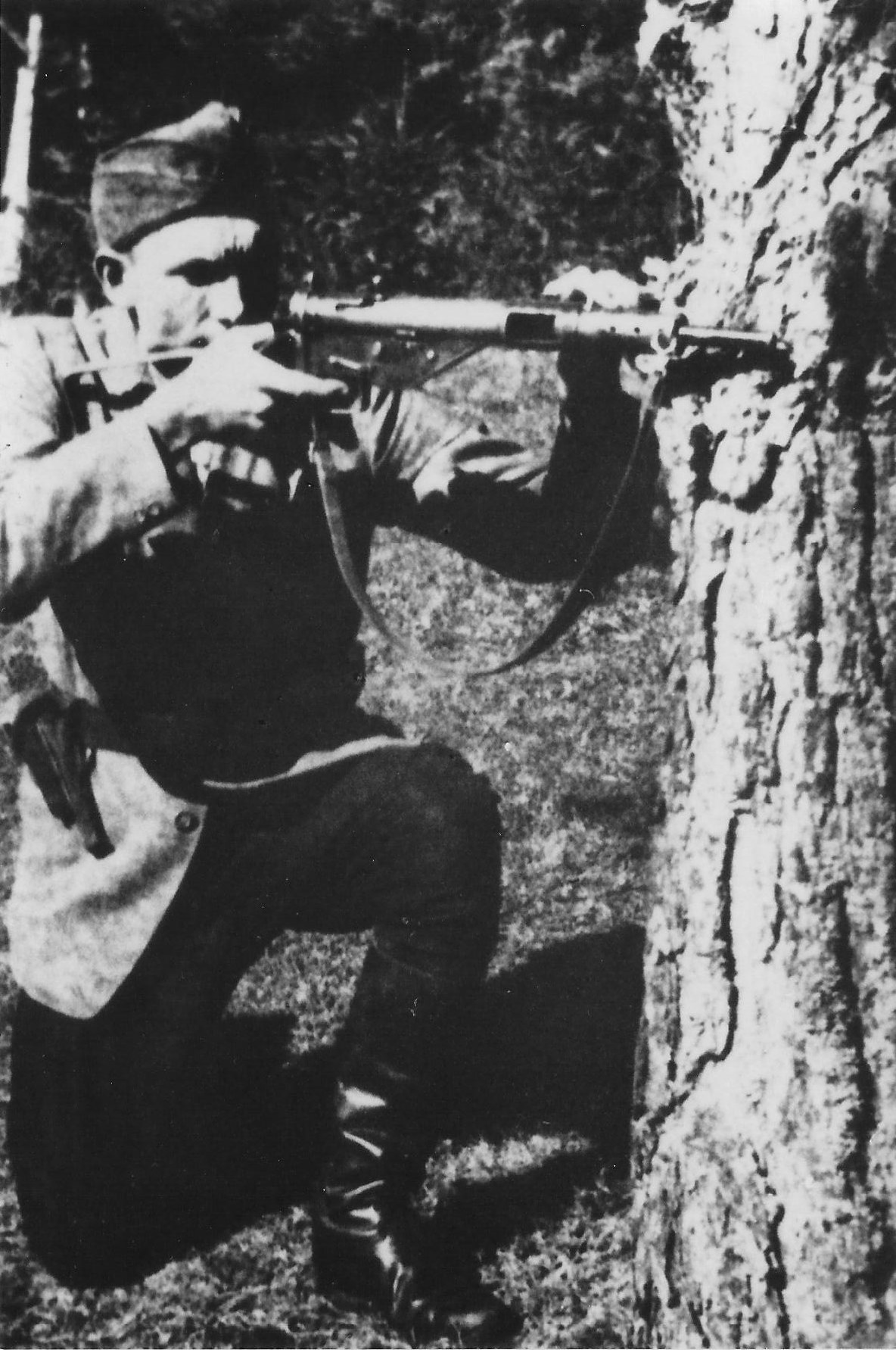
|
|
Two Wlasov soldiers were killed, the third "Ivan" taken prisoner with his concertina and in some time he was assimilated into our section and with his music entertained our "forest" life.
After our unit got demobilized he stayed on in Glisne hiding from the Russians; he was lost after the war in circumstances unknown to me. We acquired weapons, ammunition, horses, carts with no losses on our side."
NOTE: 2nd Lt. "Dick" was in command on this mission. He was sent to our unit from the Inspectorat in Nowy Sacz to be "Adam's" second in command. He was a pre-war officer.
He was killed in a chase in Olszowka after the war.
16. "MSZYCA" OPERATION ASSAULT ON SS-OFFICERS IN NUNS' LIVING QUARTERS IN MSZANA-DOLNA
(A story by Kazimierz Romanski "Romek")
We came down from the YMCA camp on Lubogoszcz to the place in Mszana Doina where the nuns lived and got there at dusk. The building was situated on the main street among other buildings
loosely stretched along the street not too far from the railway station.
Wladyslaw Kroczka "Gawor" gathered the intelligence and found out that two German officers lived there. After the war Jan Szaller "Cien" told me that they were the commanding officers of an SS unit whose soldiers
stationed scattered around neighbouring homes. "Gawor","Cien", Stanislaw Kisiel "Kora" and I made up our team. "Gawor" said that the Germans were in their room, which was located to the right at the end of a hallway.
"Kora" walked first wearing a Slovak uniform carrying an MP (machine pistol). I walked just behind him, wearing a German overcoat and holding a revolver in my hand. I stopped on the left side of the door.
"Cien", who led the patrol wore a streetcar driver's uniform and held a "Sten" gun. He appeared right at the door. In the middle of the room stood a table with a kerosene lamp on it. Both officers were reading,
one at the table without a uniform, and the other on the sofa across from the door. "Kora" approached the one at the table and called on him in German to surrender and to put his hands up.
The big guy stood up very slowly lifting his hands. When his hands were about chest high, he grabbed "Kora's" pistol. "Cien" fired a short burst at him from his "Sten". I opened fire at the other man on the sofa
and "Cien" sprayed him with bullets as well. lt only took a few seconds. We had to retreat fast because of the shooting.
Unfortunately, we missed our objective, which was to take their weapons.
We ran towards the Mszanka River then slowed down and walked back to our camp.
17. "MSZYCA" OPERATION SINGLE-MAN TASK
(From "Adam's" verbal account written by his brother-in-law Jakub Sobieski "Karol Swierszcz".)
"MSZYCA" 1944 Photo 74: Partisan Soldiers in Ambush
Photo Courtesy:
Estate of Józef Węglarz "Mały"

|
|
"MSZYCA" 1944 Photo 75:
Photo Courtesy:
Estate of Józef Węglarz "Mały"
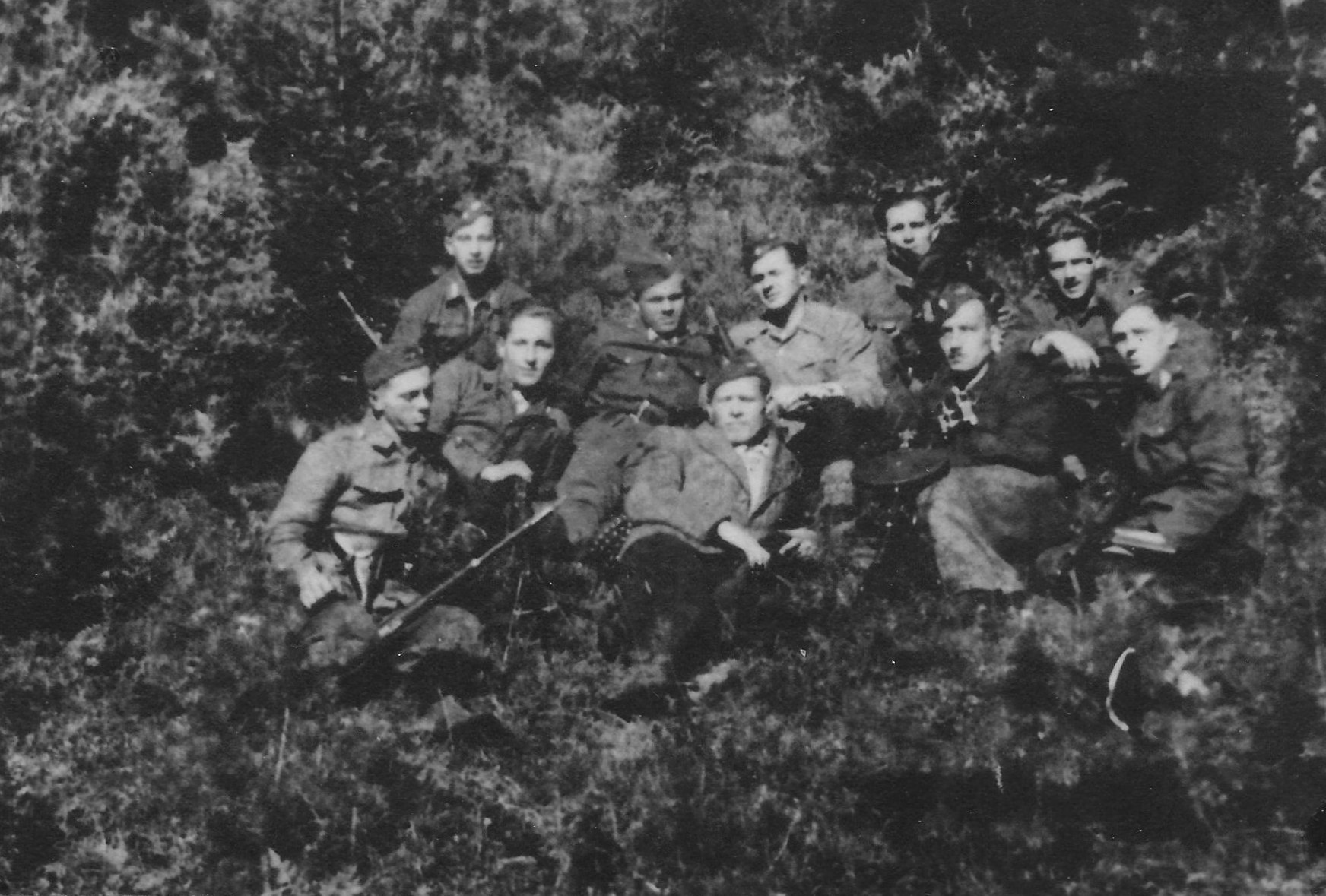
|
|
Generally there were no one-man missions.
One of our men nicknamed "Kominiarz" meaning a chimney sweep for his civilian-life profession was very clever and lucky.
He liked to walk barefoot, for no particular reason, and taking chances was like playing a game to him. One could say his second nature.
As a chimney sweep he knew everything that was going on in the town of Rabica.
One day he asked "Adam" for permission to go on a mission by himself to disarm two Germans: a physician and a priest who lived in a villa on Mount Slone.
�Adam" agreed but under a condition that he would take a couple of guys as backup. Off they went and when they got to the villa "Kominiarz" climbed the rain pipe to the balcony and disappeared in the room.
It took a long while until the front doors opened and "Kominiarz" reappeared accompanied by the doctor in his uniform who saluted him good bye.
"Kominiarz" was wearing German boots and held a revolver in each band.
We couldn't wait to hear his story. He told us that he slipped in so quietly that they were still asleep. He grabbed the captain by his big toe shook him to get up and give up their guns.
The doctor replied "We will comply, just tell us how you got in". So he did and asked them to escort him to the door.
By the way this was not the only unbelievable event involving "Kominiarz". On another occasion he went to town alone on some private business.
"Adam", however, sent a guy to follow him as a backup and the latter one witnessed how "Kominiarz" went by a group of German soldiers who also saluted him and did not even stop him.
NOTE: "Kominiarz" was the nickname of Stanislaw Luber "Indyk" who died on Oct. 25, 1944 (See operation #12 above)
18. "MSZYCA" OPERATION RAID ON SS QUARTERS IN RABKA
The entire unit including our "Storm" group under Roman Miedwicz "Morski" took part in this unsuccessful operation.
In the dark of night we approached the Germans' quarters through a rough and unknown terrain. The lack of complete silence on our part alarmed the guards and we found ourselves under fire.
Jozef Makula "Tygrys" fired a long burst to where the shots were coming from. We withdrew rather chaotically; fortunately, we sustained no losses.
19. "MSZYCA" OPERATION ATTEMPTED DISARMING OF SS SOLDIERS IN CHABOWKA
"Adam's" oral report.
We stationed in Jasionow settlement on Olszowka before that mission.
A woman working as a caretaker around the SS unit supplied us with their daily timetable and the floor plan.
According to her each of the 25 soldiers carried a handgun at all times and was also equipped with a machine pistol.
The sleeping quarters were upstairs and the dining hall was on the first floor - one long table with benches on both sides.
Each soldier kept his machine pistol hanging behind him right on the wall during a meal.
A corridor led there from the outside. The supper was at 7 PM every day for all the SS men.
"Dick" was in charge for this mission. His second was Stanislaw Skowronski "Skowronek" a son of the church organist from Rabka.
They had over a dozen of experienced partisans with them among them "Tygrys", "Goliat", and "Boa".
At first all went according to plan. "Dick" and "Skowronek" entered the corridor. "Dick" nervously entered the dining hall and yelled, "Hands up!"
Suddenly, the Germans dove under the table as one. This reaction surprised "Dick" a bit, so he had no choice but to open fire, since the soldiers reached for their handguns. "Skowronek" joined in and both emptied their
magazines into the twirling bodies under the table. They retreated quickly without any losses but the operation was not considered a success since their goal was to obtain the weapons. We were also concerned about the
fate of the woman who informed us but she was not arrested. There wasn't any immediate German reprisal against the local civilians either. We were unable to determine how many killed or wounded soldiers the SS group suffered.
20. "MSZYCA" OPERATION PROVIDENCE GUARDS OUR COMMANDER
Our section stopped fora rest on Letowe, Weglarze settlement near the school.
"Adam' made sure that all access points were secure by men on watch duty and then decided he needed some rest.
He climbed a loft with some hay on the floor and lay down. He woke up to investigate some noise downstairs and a shot rang suddenly.
He came down and asked what happened. It turned out that our patrol securing the road to Lubomierz stumbled upon a couple of alleged escapees from a POW camp.
Suspicion was the fact that they could not name the POW camp that they escaped from. Our boys disregarded the protocol and brought the two to our camp.
"Adam" immediately put the whole section on alert and, with an unusual for him, excitement started an investigation.
He was told that the newcomers were shown hospitality, fed a dinner, and wanted to impress the boys with some fancy rifle handling. A shot was fired into the ceiling where just a moment ago "Adam" was sleeping.
After he heard this "Adam" climbed back to the loft and he noticed with horror a huge hole in the exact spot where he slept just moments ago.
This event shook up the entire unit.
We thanked God for sparing "Adam's" life.
"Adam" himself reminisced later that he owes his survival to his mother's prayers.
I ("Mały") do not recall precisely but I think that the two POW's responsible for all this were delivered to the regiment's headquarters in Szczawa where they kept the escaped POW's in safe houses.
I had a chance to visit one of these safe houses when one of the escaped POW's was a US flyer of the Polish descent, shot down in the region, whose name was Tadeusz Dejewski.
I also heard another version of the story in which the ones responsible for the shooting were "Hubert" and "John". This version cannot be true because I knew them personally and we met in the old section "Wilk"
a lot earlier - in December of 1943, before the destruction of our dugouts on Czerwone Gronie.
Editor's Note: See also Section 3.9: Foreigners Fighting With And Protected by the AK
Do NOT think it is any of the aircrew mentioned there were the POWs mentioned above - as per their stories as stated in Section 3.9.
Downed Allied aircrew often passed themselves off as escaped POWs -- as sometimes the reception was not too friendly from personnel on the ground that had just been bombed!
NOTE: The above list of 20 "MSZYCA" OPERATIONs is surely incomplete for "Mały" did not participate in all of the operations. Thus, his recollection of those "other" missions is insufficient for the purpose of documentation.
"MSZYCA" PHOTOS 1944
1944 "MSZYCA" Photo 33: Józef Węglarz "Mały" With Rifle
Photo Courtesy:
Estate of Józef Węglarz "Mały"
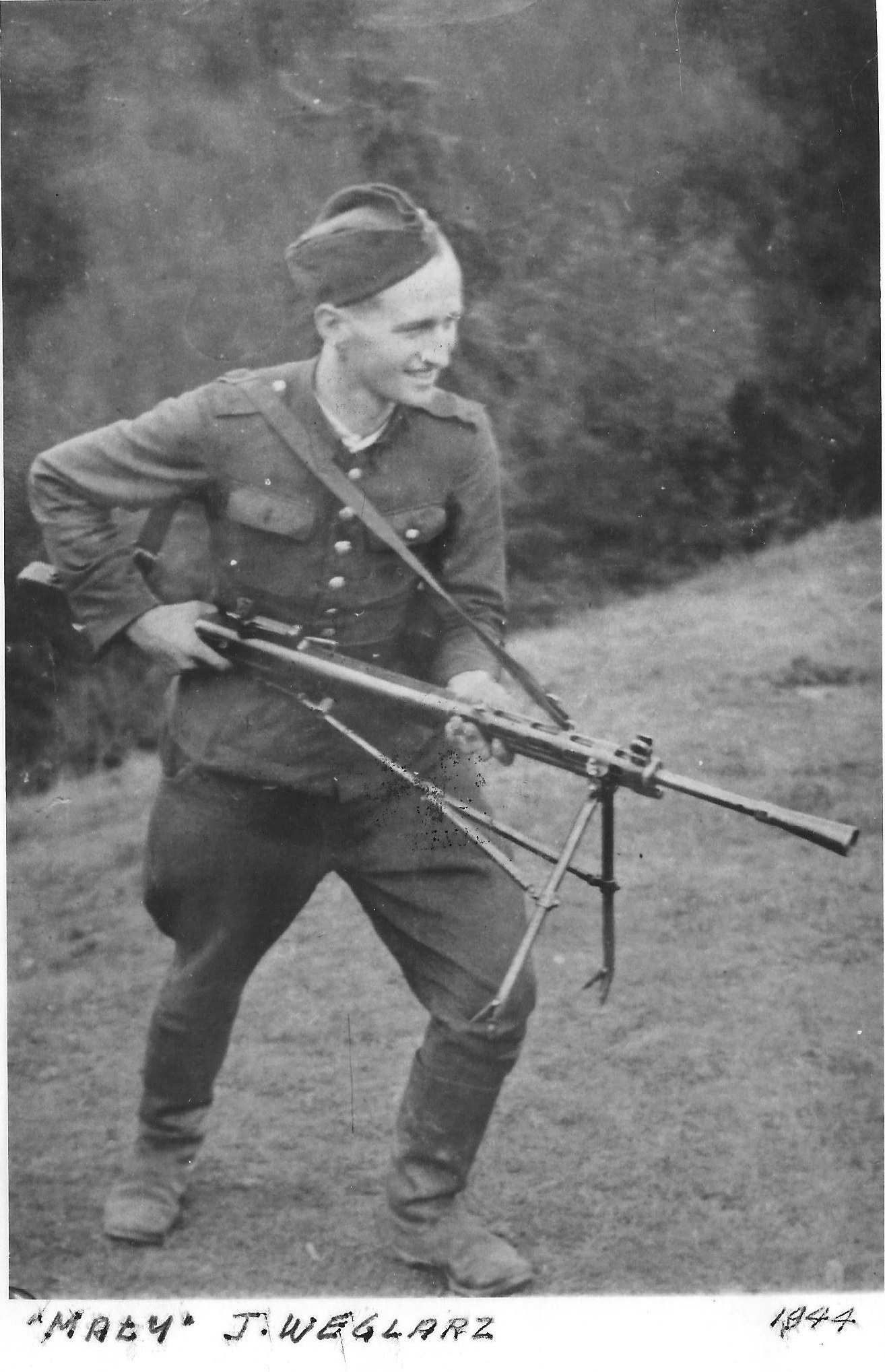
|
|
1944 "MSZYCA" Photo 56: Adam Hubiszta "Łoś"
Photo Courtesy:
Estate of Józef Węglarz "Mały"

|
|
1944 "MSZYCA" Photo 85: Stanisław Skowroński "Skowronek"
Photo Courtesy:
Estate of Józef Węglarz "Mały"

|
|
>
1944 "MSZYCA" Photo 29: Józef Węglarz ps Mały
Photo Courtesy:
Estate of Józef Węglarz "Mały"

|
|
1944 "MSZYCA" Photo 89: Stanisław Janas "Wilk"
Photo Courtesy:
Estate of Józef Węglarz "Mały"

|
|
1944 "MSZYCA" Photo 22: Józef Węglarz "Mały" with German Shepard
Photo Courtesy:
Estate of Józef Węglarz "Mały"

|
|
1944 "MSZYCA" Photo 23: Józef Węglarz ps Mały With Machine Gun
Photo Courtesy:
Estate of Józef Węglarz "Mały"

|
|
1944 "MSZYCA" Photo 26: Józef Węglarz ps Mały
Photo Courtesy:
Estate of Józef Węglarz "Mały"

|
|
"MSZYCA" Photo 28: NN and Józef Węglarz "Mały" Winter 1944
Photo Courtesy:
Estate of Józef Węglarz "Mały"

|
|
"MSZYCA" 1944 Photo 48a: Thought To Be Of Adam Trembecki "Miś"
Photo Courtesy:
Estate of Józef Węglarz "Mały"

|
|
Photo 48: Józef Węglarz "Mały" in 1943 or 1944
Photo Courtesy:
Estate of Józef Węglarz "Mały"

|
|
"MSZYCA" 1944 Photo: Antoni Malec "Kmicic"
Photo Courtesy:
Estate of Józef Węglarz "Mały"
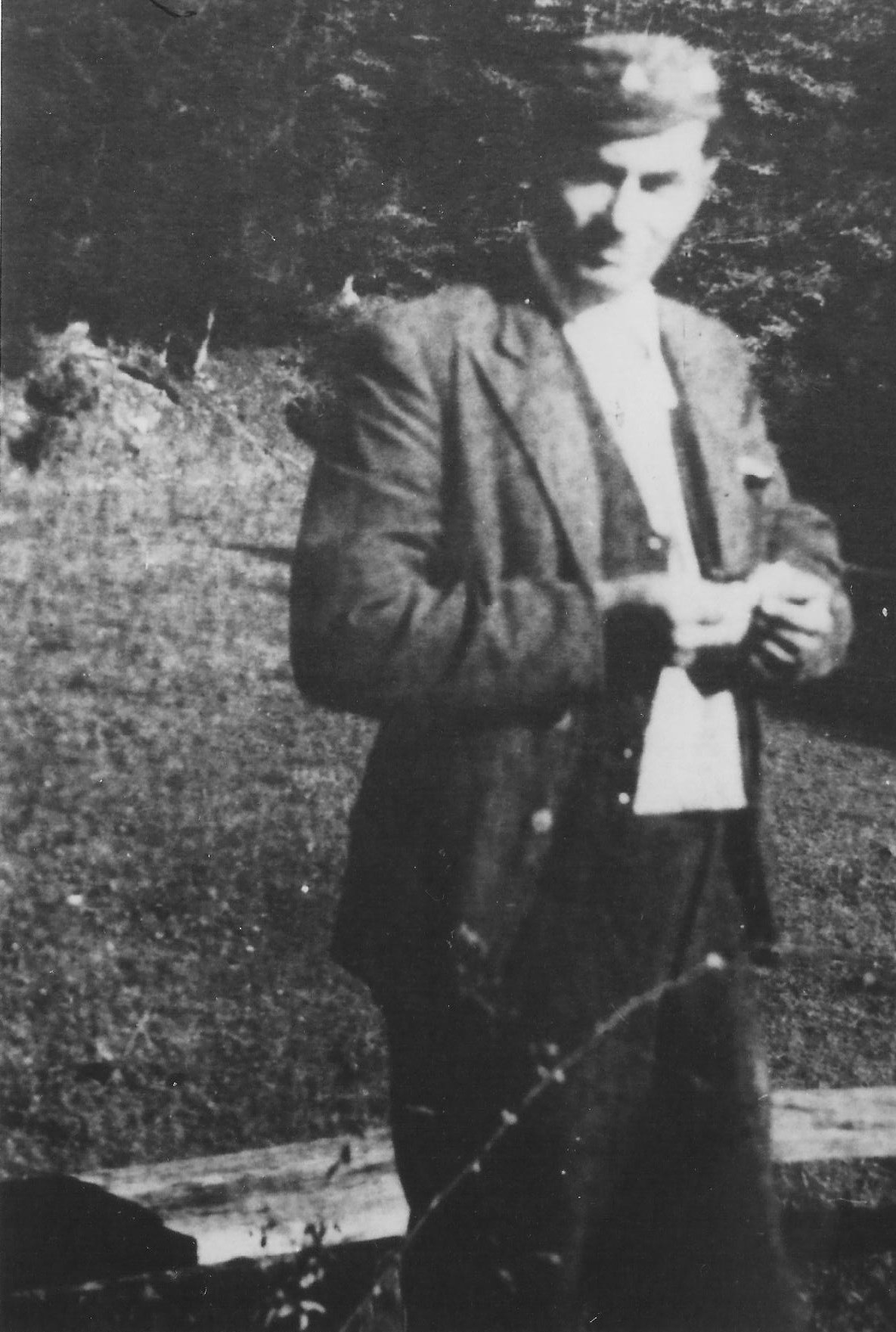
|
|
"MSZYCA" 1944 Photo 61a: Adam Trembecki "Miś"
Photo Courtesy:
Estate of Józef Węglarz "Mały"
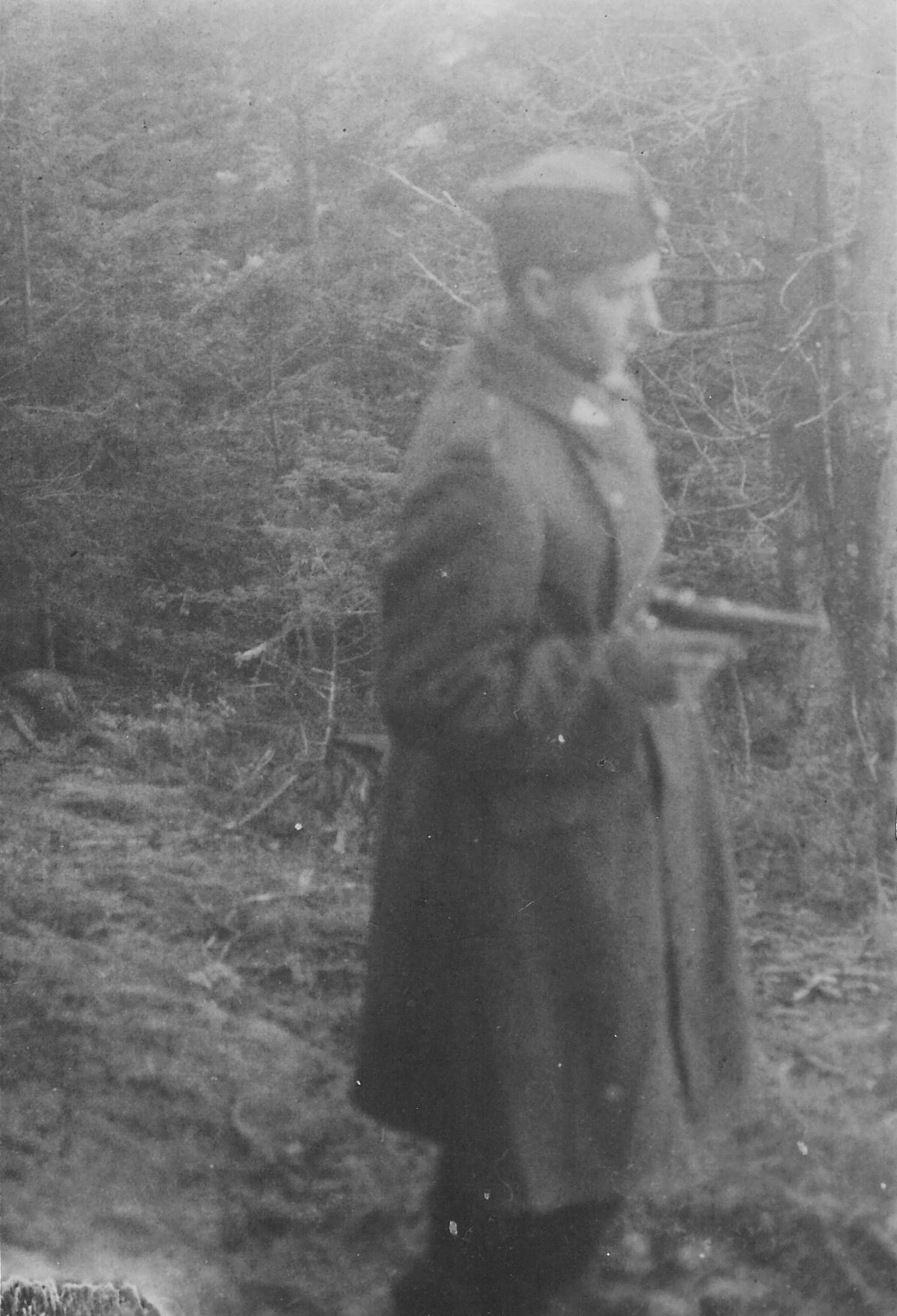
|
|
"MSZYCA" 1944 Photo 61:
Photo Courtesy:
Estate of Józef Węglarz "Mały"

|
|
"MSZYCA" 1944 Photo 86m: ?" Michaś"?
Photo Courtesy:
Estate of Józef Węglarz "Mały"

|
|
"MSZYCA" 1944 Photo 57: Left to Right:
Adam Hubiszta "Łoś", Władysław Kępa "Ferdek" and Jósef Sojka "Soika"
Photo Courtesy:
Estate of Józef Węglarz "Mały"

|
|
"MSZYCA" 1944 Photo 76: NN, Wicker, Lock, Mier
Photo Courtesy:
Estate of Józef Węglarz "Mały"

|
|
"MSZYCA" 1944 Photo 86: Józef Węglarz "Mały" and Zygmunt Gąsiorowski "Sosna"
Photo Courtesy:
Estate of Józef Węglarz "Mały"

|
|
"MSZYCA" Late 1944 Photo 34: Left to Right: Jan Węglarz "Antek" and his brother Józef Węglarz "Mały" and Józef Dudzik "Wasyl"
Photo Courtesy:
Estate of Józef Węglarz "Mały"

|
"MSZYCA" 1944 Photo 42: plut. Tadeusz Wacławik "Długi" with German Shepard(s)
Photo Courtesy:
Estate of Józef Węglarz "Mały"

|
"MSZYCA" 1944 Photo 54:
Left to Right: Adam Hubiszta "Łoś", Wlaldek Kepa "Ferder" and Jósef Sojka "Soika"
Photo Courtesy:
Estate of Józef Węglarz "Mały"

|
|
"MSZYCA" 1944 Photo 55:
Left to Right: Adam Hubiszta "Łoś", Józef Węglarz "Mały" and NN (? Andrzej Chorągwicki "Wróbel" ?)
Photo Courtesy:
Estate of Józef Węglarz "Mały"

|
|
"MSZYCA" 1944 Photo 60 at Lubon: Left to Right:
Adam Hubiszta "Łoś", Józef Węglarz "Mały" and Władysław Kępa "Ferdek"
Photo Courtesy:
Estate of Józef Węglarz "Mały"

|
|
"MSZYCA" 1944 Photo 83 Rozpoznania: Several Partisan Soldiers including Karol Mierzwa "Wicher" and Józef Węglarz "Mały" (left arm on rocks with gun)
Photo Courtesy:
Estate of Józef Węglarz "Mały"

|
|
"MSZYCA" 1944 Photo 87: 1. Andrzej Chorągwicki "Wróbel", 2. Józef Węglarz "Mały", 3. Adam Hubiszta "Łoś", 4. "Bury"
Photo Courtesy:
Estate of Józef Węglarz "Mały"

|
|
"MSZYCA" 1944 Photo 73
Photo Courtesy:
Estate of Józef Węglarz "Mały"

|
|
"MSZYCA" 1944 Photo 47: Janek Węglarz "Antek" and his Brother Józef Węglarz "Mały" on Horseback
Photo Courtesy:
Estate of Józef Węglarz "Mały"

|
|
"MSZYCA" 1944 Photo 92:
Photo Courtesy:
Estate of Józef Węglarz "Mały"

|
|
1944 "MSZYCA" Photo 27: Józef Węglarz ps Mały Preparing for Nazi Ambush
Photo Courtesy:
Estate of Józef Węglarz "Mały"

|
|
1944 "MSZYCA" Photo 91: Andrzej Chorągwicki "Wróbel" Holding Ammunition Clip for Józef Węglarz "Mały"
Photo Courtesy:
Estate of Józef Węglarz "Mały"

|
|
1944 "MSZYCA" Left to Right: Kazimierz Romański ps. "Romek and Adam Hubiszta ps. "Łoś
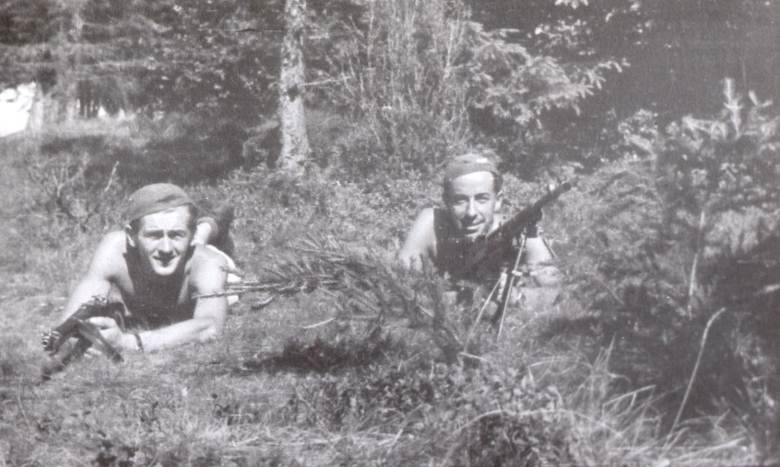
|












